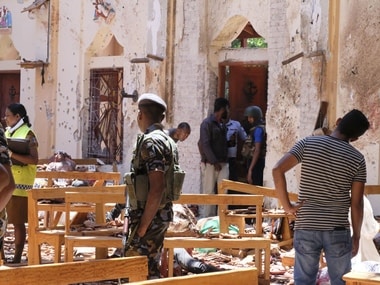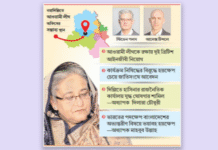Sri Lanka blasts: Doubts remain over Islamic State’s involvement, but it’s clear a dangerous force helped recruit youth, execute plan
Tara Kartha Apr 24, 2019 First Post
On an afternoon in October 2016, sleuths from the National Investigation Agency moved swiftly to arrest a group of young men in Coimbatore in Tamil Nadu, over links to the Islamic State. That investigation was in turn tied to the NIA’s earlier unearthing of a module in Kannur in the state of Kerala, that was planning to target important persons. The subsequent investigation led the agency to others parts of south India and to the arrest of recruiters like Abu Bashir who used social media to recruit dozens in both states. Among them was Abdul Rashid Abdullah, who along with a group of 20 others, had reached Syria. Another Shaibu Nihar from Calicut was among those wanted in an Islamic State case at least ten years ago.
Terror investigations never really formally end. The patient unearthing of evidence and linkages that emanated from this Islamic State trail, continued over the next three years, with leads going in different directions and into different countries. One of those trails seems to have led straight to Sri Lanka. And no, that trail is not yet over. In fact, it may have just begun.

We now know that Indian intelligence had precise intel about the suspects, even disclosing the name of Zahran Hashim, who has been identified on one of the men on the video claimed by the Islamic State. That suspicion is yet to be confirmed since no one knows who made and put up that video, and whether Islamic State Central was allowed to take the credit.
Intelligence seemed to point a finger at the National Thowheed Jama’ath (NJT) with Hashim appearing to be the leader. Oddly, he’s the only one who is without a mask in the videos that were circulated. Why the others chose to hide their faces is unclear. Again, it is uncertain why the Islamic State waited 48 hours before making a claim on Amaq News Agency, which is in essence, a statement of events as they happened. And finally, there is the fact that the intelligence warning also included a planned attack on the Indian embassy. The only bomb which was found and defused was near the airport.
It could be that investigators were merely being extra cautious in warning the High Commission of India in Sri Lanka. Again, Sri Lanka defence minister Ruwan Wijewardane’s claim in the Sri Lankan parliament that the attack could have been a reprisal for the Christchurch attack on mosques has been questioned rather justifiably. An operation of this scale — probably the worst that Islamic State has ever laid claim to — would have required months of preparation.
The main difficulty is not in finding the reported seven suicide bombers as most seem to think, but to find out how they shipped and assembled the explosives. Explosives of any kind are hard to find, and extremely difficult to push through normal smuggling channels. Those are the dissonant factors.
There are undoubtedly similarities to other Islamic State-claimed attacks and the Sri Lanka blasts. Sri Lankan authorities are claiming that the attack was done by the local group, the NJT, a claim that is being doubted by many who see it as a group that is virtually invisible on social media or anywhere else. That the NJT was used by the Islamic State seems hard to believe. However, it is worth remembering that the Islamic State did use another local group to commit one of worst atrocities in Bangladesh. This was the Jama’atul Mujahideen Bangladesh (JMB) which attacked the Holey Artisan Bakery in 2016. And here’s another bit that could be a link to the present attack. The main arms supplier and financier Mamnur Rashid was caught in mid January 2019 in Dacca, after he tried to use a ‘neighbouring country’ to regroup. That arrest could have provided additional leads to the Islamic State/extremist networks criss-crossing South Asia and beyond.
There are certainly stark similarities between the two attacks. First, the terrorists responsible for the attack were again well educated, and from wealthy families. Second, all were locals. No Syrians, or Iraqis or anyone else. Third, the leader Tamim Ahmed Chowdhury was a Canadian of Bangladeshi origin. In this case, the role of the Islamic state, as evident from communications between Tamim and his mentor Abu Tarek, was primarily around targeting advice and probably finance. That’s another investigation that is still ongoing as the recent arrest indicates. Despite these striking similarities, however, it must be remembered that the Sri Lankan NJT is not even a fraction of the JMB in terms of its capabilities. Nor did it show any signs of being against the Christians. Its fulminations were against the Buddhist extremists. Something is not quite right. In Sri Lanka, there is talk of a conspiracy. That’s the worst way to go for the country.
In sum, however, it is clear that there is a very dangerous force at work, which may call itself the Islamic State or may be something that uses the name for its own quasi political purposes. These provide a sourcing platform for young, intelligent and dissatisfied youth who are able to get in touch with mentors for advice on how to conduct an attack. Such youth in turn are recruited by nameless anonymous figures, who may never ever themselves be involved in any violent act, and are invisible to police or the intelligence radar.
For India, the only saving grace has been that strong streak of secularism — the real thing and not the fake one being peddled by politicians — has kept the notion of the religious ‘other’ at bay. Indians, particularly in central and south India, have been accustomed to accepting every and any religion as an occasion to eat and make merry. That’s changing. And what is being seen now in the recent arrests are the initial effects. Sri Lanka has been in danger for a long time. In India, it has just begun.









